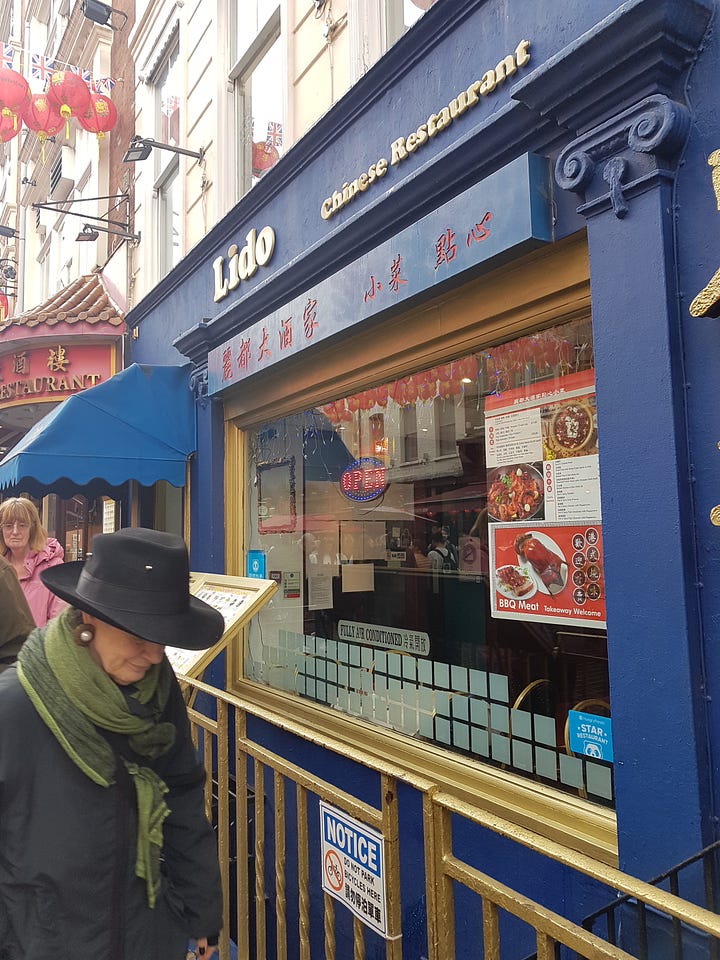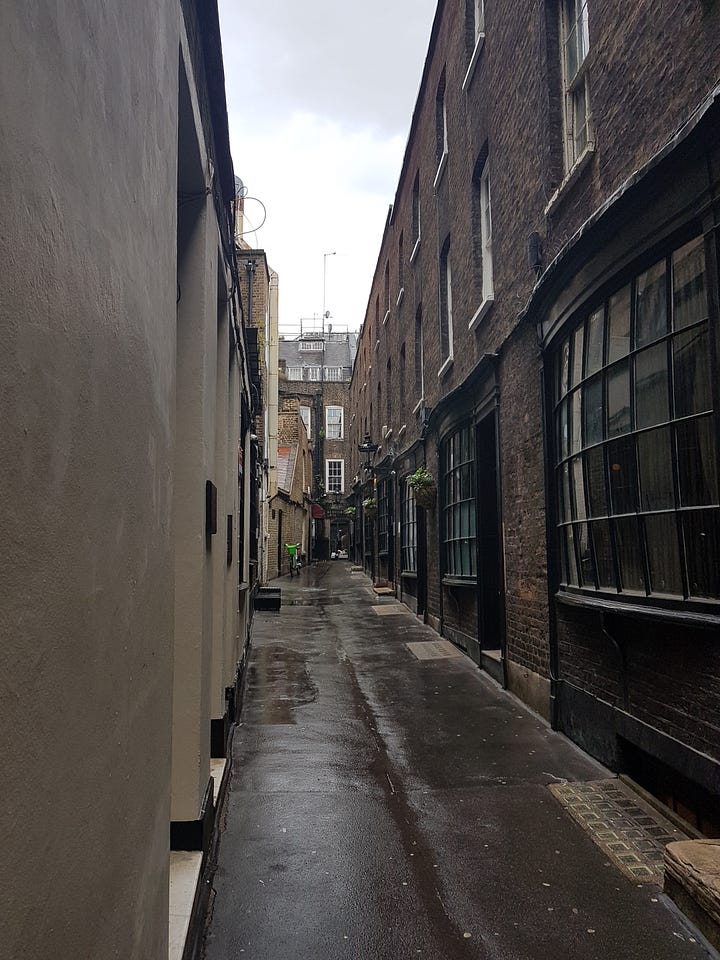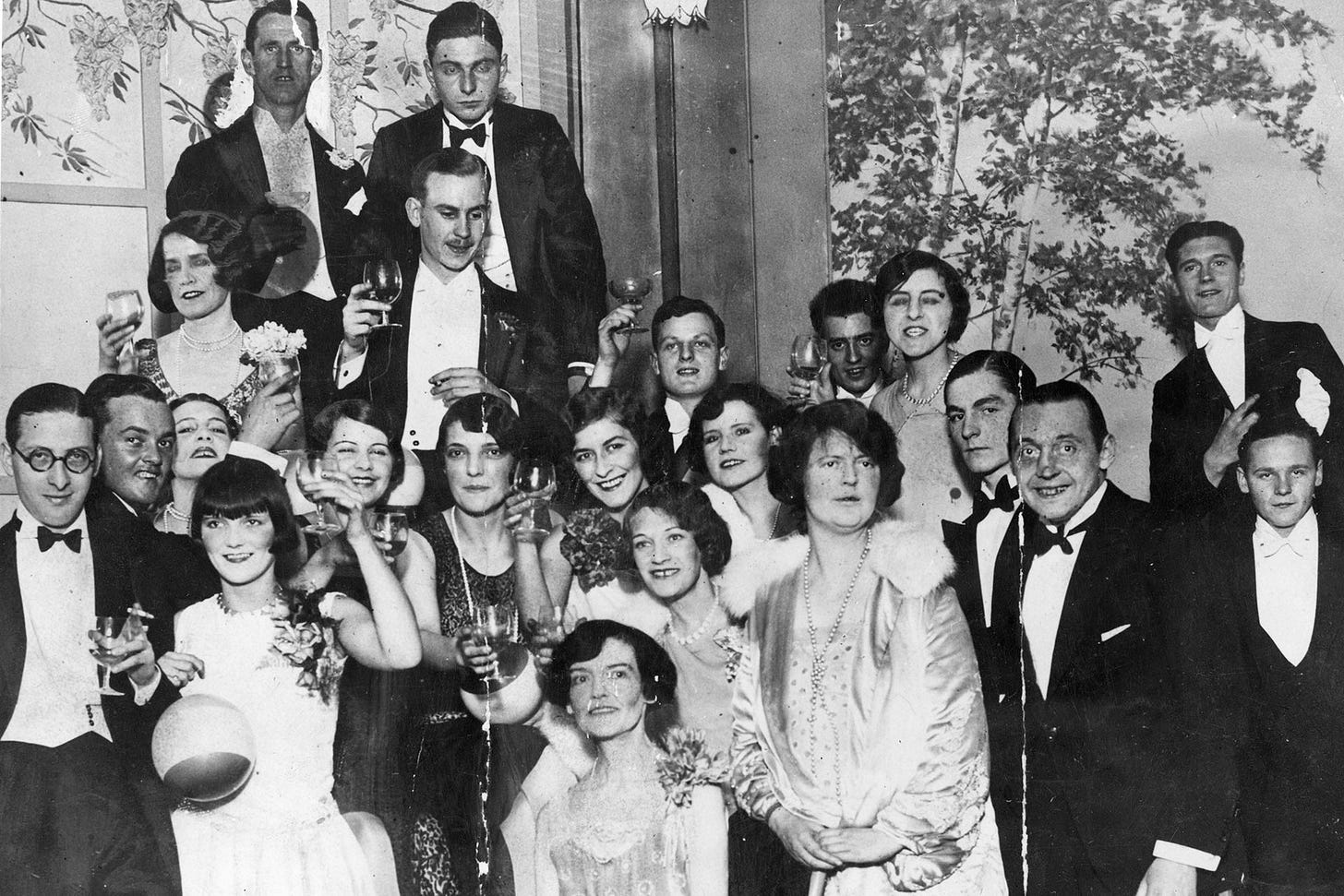If you enjoy this post, please hit the ‘like’ button at the bottom - it’s free and it helps others discover my posts.
I love to walk through London’s history. When I was preparing to write my second 1920s mystery, The Soho Jazz Murders, I booked onto a walking tour to learn about the criminal history of the West End. The tour was run by Footsteps of London, which organises reliably quirky walks, often off the beaten tourist track.
It was a rainy afternoon, which only added to the atmosphere as we toured the back alleys and courts of old London (photos below), hearing hair-raising tales about bent coppers, murderous lords and shady Soho pornographers. As we turned into Gerrard Street in Soho, I told our guide that I was writing crime fiction set in 1920s London, and my next book would be set in a nightclub.
‘Do you know about Kate Meyrick?’ he asked. I didn’t. But I soon did. ‘Kate Meyrick - 43 Club,’ I scribbled into my soggy notebook.
Kate Meyrick entered the night club scene in her 40s, primarily to support the eight children she’d been left to bring up alone, after divorcing from her doctor husband. She grew to notoriety, with a series of clubs that catered for royalty (British and Hollywood), gangsters, notorious flappers, hot jazz bands and more. They were routinely raided by Bow Street police - albeit usually after a decent warning to allow them to prepare - under the strict licensing laws of DORA (see post here).
Two of her daughters married into the aristocracy, tying the knot with the clubs’ better-heeled clients. Mrs Meyrick herself was jailed five times for license breaches. She opened her most famous establishment, the 43 Club on Gerrard Street, in 1920. Customers included actors Rudolph Valentino and Tallulah Bankhead, as well as authors Joseph Conrad and Evelyn Waugh, who immortalised her as ‘Ma Mayfield’ in Brideshead Revisited (Sebastian takes his teddy to visit). The Egyptian prince Kamel Bey, later shot dead in the Savoy Hotel by his wife, was another patron.
As well as drinking and dancing, a night at the 43 Club might involve a shoot-out between gangs, fights between army and navy officers (regular clients) and a mass exodus out the back exit as policemen clattered down the stairs to investigate reports of out-of-hours drinking.
For a historical novelist, the best thing Kate Meyrick did was write her memoirs. Secrets of the 43 Club is an absolute treasure house of information - some likely accurate, some blatantly self-serving. My favourite is the chapter that deals with the business end of the clubs - how much she paid for the champagne, the going rate for a top-class band (£350 a week for Teddy Brown’s orchestra) and so on. Breakfast of bacon, eggs and kippers was provided, to keep the customers going longer.
She wrote: ‘Champagne cost on average 12 shillings 6 pence per bottle and I sold it during licensed hours for 22 shillings 6 pence to 30 shillings, and after legal hours at 30 shillings to £2 per bottle.’
Perhaps unsurprisingly, there was money to be made. ‘If I personally made £100 in a given night, I suppose the entire club took £250. The waiters and the dance hostesses between them would certainly make more than I made... From 1919 to 1932, £500,000 passed through my hands.’ The biggest earner was Boat Race night, as undergraduates celebrated after the Oxford/Cambridge boat race on The Thames. In 1927, the club took £600 in a single boat race night.
‘I discovered that men will pay almost anything to be amused,’ she noted.
I was fascinated by her account of how she recruited the ‘dance hostesses’ who entertained the clients and kept them spending freely.
‘I chose them primarily for their ability as dancing partners, but they were also very beautiful,’ wrote Mrs Meyrick. ‘Practically every one of them either had been on the stage or was still on it. They were mostly girls who had worked in the choruses of musical comedies or revues, which meant they were superb dancers and knew how to wear their clothes, while not a few were talented in some direction such as acting or singing.’
She tackled head-on the accusation that they were little more than prostitutes. ‘To say that every girl I engaged for my clubs had always been a ‘good’ girl would be to say too much. But this I say in all sincerity: the Meyrick clubs have always made it worth the while of their dance hostesses to keep straight, and many a young woman has admitted to me that only the earnings she was able to make in one of my clubs had saved her from turning to a degraded means of gaining her livelihood.’
I plundered all this shamelessly for The Soho Jazz Murders, much of which takes place in the fictional Harlequin Club, presided over by the formidable Violet Crumb. I send my sleuth Marjorie Swallow to work undercover as a dance hostess, hoping she would live up to Mrs Meyrick’s standards: ‘The type of girl suited to the life is a well-balanced, sensible young woman who is able to keep her head and look after herself.’ Fortunately, Marjorie’s skill in jiu-jitsu means she’s able to do just that.
Research tip
I love doing my research on the ground, and a walking tour is a great way to find out more about local history. The guides are usually incredibly well-informed and full of stories. Blue Badge guides all have qualifications in London history, while Footsteps of London do more off-beat tours in lesser-known parts of the city. My friend Fiona Lukas (who also has an entertaining podcast, Ladies Who London) is a terrific guide and inspired me to make Helen Oddfellow, the sleuth in my first series of novels, a London tour guide.


Favourite research find
I discovered that Mrs Meyrick made friends with the 40 Elephants Gang - an all-women gang of shoplifters and crooks from the Elephant and Castle area of south London - while in prison. The gang was known for blackmailing crooks. I made loose use of this connection in enacting a very satisfying revenge on a pair of gangsters in The Soho Jazz Murders.
Incidentally, I’d almost finished writing my novel when Kate Atkinson, one of my favourite authors, published Shrines of Gaiety, a 1920s-set novel clearly inspired by Kate Meyrick’s story. Shrines of Gaiety is a terrific read, as are all her books, and it was fun to spot what she’d also borrowed from Secrets of the 43 Club!
Thanks for reading! Please do hit the ‘like’ button - it helps other people find my posts.








I thoroughly enjoyed The Soho Jazz Murders, Anna. And reading this background to it is thrilling!
This is totally fascinating. Thank you for sharing!